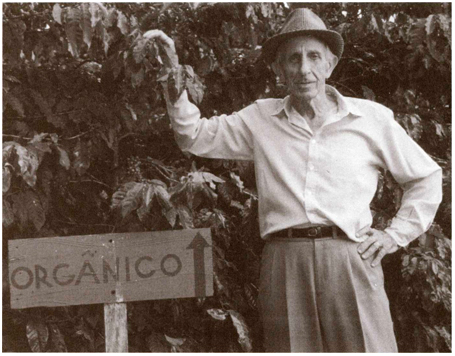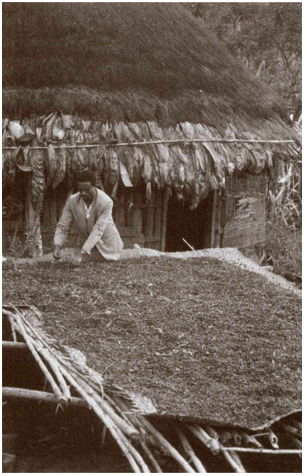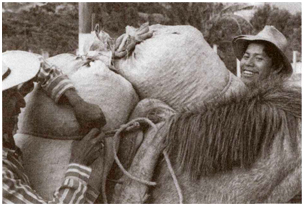
6 HOW IT CAN MAKE THE WORLD BETTER
Coffee, people, and environment
Organic, shade-grown, fair-trade, and sustainable coffees

Coffee ranks with oil and steel as one of the world’s most intensely traded commodities. Many smaller countries depend on coffee for almost all of their foreign exchange. Millions of families worldwide depend on coffee for their livelihood. The majority are subsistence farmers who tend a few trees along with some chickens and vegetables and count on the coffee to bring them just enough cash to buy the few tools and staples they need to survive.
THE SPECIALTY-COFFEE STRATEGY
As the specialty segment of the coffee industry grows in power and sales figures, it has occurred to many people that niche marketing of specialty coffee can be a tool to help both coffee growers and coffee-growing countries lift themselves out of poverty. To put it simply, if coffee sells as a complexly marketed specialty beverage like wine rather than an anonymous, price-driven commodity like branded supermarket coffee, and if some of the premium paid for those complexly marketed specialty coffees actually makes it back to the pockets of substistence growers rather than staying in the hands of marketers and dealers, then specialty coffee becomes part of a self-regulating, market-oriented solution to the rural poverty that haunts many parts of the tropics.
And, from an ecological point of view, coffee is a crop that is already easier on the environment than many competing crops. Most of the small subsistence farmers I described have never used agricultural chemicals, and grow their coffee mixed in with other crops and often in shade. I recall being in parts of Central America where it is difficult to pick out the coffee trees from the rest of the random tangle of fruit trees and vegetables. Even traditional larger farms with neatly tended shade trees and windbreaks tend to be far more ecologically sound in their agricultural practices than large farms that grow many other cash crops. Consequently, specialty coffee also offers the opportunity for concerned consumers to reward environmentally sound agriculture and discourage destructive practices.
In the very broadest sense, every time you buy a coffee on the basis of origin from a specialty vendor rather than on the basis of price from a supermarket you are supporting a market-based solution to tropical poverty and environmental degradation. In fact, you are helping everyone. You are helping yourself to better coffee and a more expressive choice of coffee; you are helping a college-student clerk work at something slightly more interesting than taking orders at a fast-food outlet; you are helping roasters, dealers, and exporters lead more interesting lives based more on shared passion than on pure number crunching; and you are recognizing and rewarding the hard work of mill operators and growers.
All of this for a few cents more per cup.
SPECIFIC REMEDIES: CAUSE COFFEES
However, coffee buyers can be even more specific in their support of subsistence growers and the environment. They can choose from a growing array of what, for lack of a better term, I call “cause coffees.”

Subsistence farmer and his crop of coffee fruit, East Africa.
The Original Cause Coffees: Organics
The granddaddy of all cause coffees, and still the most impeccable in its credentials, is the organically grown category. Organics, as they are called in the coffee business, are coffees that are certified by third-party agencies as having been propagated, grown, processed, transported, stored, and roasted without contact with synthetic chemicals—particularly without contact with pesticides, herbicides, and various other-cides. The certification process is lengthy, thorough, rather expensive, and, so far as I am able to determine, largely reliable and free of abuse.
The organic movement is fueled in part by consumers’ health concerns. People are understandably wary of consuming agricultural poisons along with their vegetables. With coffee, however, the health issue is less persuasive than it is with most other agricultural products—apples or carrots, for example, which we consume whole and often raw. We do not consume the fruit of the coffee tree. Instead, we strip the fruit off and compost it, retaining only the seed, which we then dry, roast at very high temperatures, grind, and soak in hot water. Subsequently we throw away the dried, roasted, ground seeds and drink the water. It seems unlikely that even the tiny amount of chemical residue that may or may not survive in the seed actually survives roasting and brewing to make it to the cup.
Early on, however, idealists in the coffee industry—people like Paul Katzeff of Thanksgiving Coffee; Gary Talboy, originally of Coffee Bean International; Karen Cebreros, one of the founders of Elan Organic Coffees; and David Griswold, one of the founders of Aztec Harvest—seized on the organic idea with a larger vision in mind. They saw that they could work with cooperatives of subsistence growers who had never used chemicals in their growing practices, help get these cooperatives certified as organic, and market their coffees directly to specialty roasters or consumers. By doing so they could assure the growers a premium for their coffee—organic coffee, like organic produce generally, retails for more than conventionally grown coffee—and make sure, through vertically integrated, direct marketing arrangements, that a good portion of that premium actually makes it back to the growers. Growers would make more money, take more pride in what they were doing, and the environmental advantages of organic procedures would be confirmed and institutionalized.
These early organic cooperative coffees—Aztec Harvest from Mexico, Inca Harvest from Peru, and others—were successful mainly on the basis of their stories. Their quality was often spotty, owing to the difficulty of bringing disciplined processing practices to large numbers of isolated subsistence farmers. Nevertheless, these pioneer organics were successful enough to encourage many other cooperatives, farms, mills, and, eventually, international development agencies to pursue the same strategy. Today we have large-scale, internationally supported efforts to establish organic cooperative coffees from Haiti, East Timor, Papua New Guinea, and Sumatra, joining the many similar efforts taking place in Latin American countries and elsewhere.
Joining organic coffees produced by progressive cooperatives are coffees grown on larger farms that have successfully converted to organic procedures. Although most of these farms are in Mexico, Central America, and Brazil, the idea will doubtless continue to grow and establish itself in other parts of the world.
As more organic coffees come on the market produced in a variety of contexts, the overall quality of organics improves. Today, some certified organic coffees rival the finest conventionally grown origins in quality and distinction.
Project and Donation Coffees
Another tack was also taken by early specialty-coffee idealists. A percentage of the purchase price of certain coffees was put back into development projects directly benefiting subsistence growers. Coffee Kids, founded by Bill Fishbein in 1989, was one of the earliest organizations to promote this approach. Coffee roasters and retailers either make direct contributions to Coffee Kids and its development projects or contribute a set percentage of the sales price of designated coffees or other products.
Roasting companies and retailers often make their own, direct sponsorship arrangements with coffee-growing communities. A roasting company may market a cooperative’s coffee and return a percentage of the retail price directly to the community in support of various development efforts. These arrangements are typically well advertised by the companies that sponsor them, and justifiably so.
Shade-Grown and Bird-Friendly Coffees
Coffee is traditionally grown in shade in many, but certainly not all, parts of the world. In some places the arabica trees require protection from the tropical sun. In other, wetter places, shade is not practical because it encourages leggy, disease-prone trees. Shade may be provided by rows of carefully managed non-native trees that are often sterile to prevent their seeds from sprouting and competing with the coffee. In many parts of the world, however, shade is a serendipitous business, and coffee is grown by small farmers as one component in a rich jumble of native trees, fruit trees, legumes, and other vegetables. It is this kind of shade that scientists and birders discovered was providing particularly important habitat for migrating song birds, especially those that migrate through Central America.

Members of a cooperative of peasant growers bringing in bags of freshly picked, organically grown coffee fruit, San Juan La Laguna, Guatemala.
Meanwhile, more and more shade coffee was being replaced or displaced by what environmentalists call “technified” coffees. These are coffees from recently developed hybrid varieties of arabica that grow well in full sun. These hybrid trees are disease resistant and bear more coffee faster than traditional varieties. They also require more chemical fertilizers, pesticides, and fungicides, and may also display less quality and character in the cup.
The Smithsonian Institution has led a movement to define and certify coffees that are grown in the diverse, multispecies shade that prevails among many subsistence growers. The Smithsonian’s well-organized, well-publicized effort has been met with anger and hurt among many coffee growers with larger farms who feel that they are being ecologically responsible, but who feel, for a variety of reasons ranging from economic (high labor costs) to climatic (too much rain and cloud cover), that they cannot grow their coffee in dense, multispecies shade.
As I write, the debate concerning a proper definition for “shade-grown” is working its way through E-mails and coffee conferences, hopefully toward a defintion that is both fair and environmentally sound. As it is now, the only existing certification procedure is very limited. The Smithsonian Institution licenses certified organic coffees that also meet Smithsonian criteria for growth under a biodiverse shade canopy. Such ultimately environmentally correct coffees are permitted to use the Smithsonian Migratory Bird Center’s “Bird Friendly” trademark. As for other, conventionally shade-grown coffees, you will have to take the seller’s word in regard to their avian congeniality.
Fair-Traded Coffees
A Fair Trade Certified seal means that growers, usually subsistence growers, have been paid a reasonable, formula-defined price for their coffee. The fair-trade movement is quite prominent in Europe, less so in the free-trading, price-busting United States.
Sustainable and ECO-O.K. Coffees
The latest and most ambitious initiative by coffee idealists is the sustainable coffee movement, a big-tent effort to bring together everyone from cranky connoisseurs to birders, health fanatics, and social progressives. The goal is to rally them in common cause against the coffee-as-faceless-commodity system that, in its anonymous emphasis on price alone, is the ultimate cause of coffee’s exploitation of both human beings and environment.
One version of the sustainable vision has been implemented by the Rainforest Alliance, whose ECO-O.K. seal certifies that ECO-O.K. inspectors have found that qualifying coffee farms and mills meet a wide variety of environmental criteria, including wildlife diversity, nonpolluting practices, and responsible and limited use of agrochemicals, as well as social and economic criteria that support the welfare of farmers and workers.
Unfortunately, the current sustainable movement offends some supporters of organically grown coffees, who feel that the sustainable idea is a warm, fuzzy rip-off that dilutes everything they have worked for. It also bothers quality-oriented purists, who feel that the only criterion for selling coffee should be how good the coffee tastes in the cup. Time will tell whether the inclusive goals of the sustainable movement can be turned into a practical system with clear and verifiable criteria satisfactory to coffee’s many passionate voices and communities.